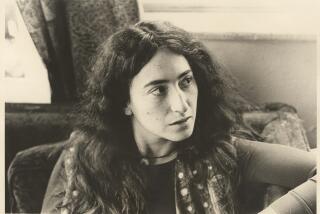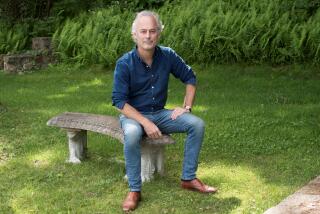A tapestry of secrets
ON a fall afternoon, the harbor at Camden, Maine, is glistening, splendid, with wooden boats and white sails and the small sounds of sea gulls and halyards and rigging. All roads into Camden funnel onto one main street that leads first to the library and then, just a few doors down, to Richard Russo’s house. Toward the center of this street is the Camden Deli, where Russo wrote much of his sixth and newest novel, “Bridge of Sighs” (Alfred A. Knopf: 528 pp., $26.95).
Russo keeps an eye out for visitors on his bright, glassed-in porch. His is a house of doorways that lead to hallways within hallways. The author, compact and almost always smiling, likes to watch visitors disappear into closets and reappear, perplexed. How old is it? Even Russo doesn’t know. “So old,” he says, “it could have a ye in front of it.” This sends him.
It would be difficult to imagine a setting more distinct from the working-class upstate New York of many of Russo’s novels, including “Bridge of Sighs.” It is also difficult to imagine such a happy man writing such a deep, dark book, a tapestry of a novel with so many threads that a reader worries, like a small child, that they might not be properly woven by the end.
For one thing, the novel’s main character, a civic-minded 60-year-old named Louis Charles Lynch (otherwise known as Lucy) has inherited such a thick veneer of blinding optimism from his father, Lou Sr., that he may not be up to the task of unlocking the secrets of his childhood. His old friend Bobby Noonan, now a well-known painter living in Venice, has been on the run from his own past -- particularly his memories of a cruel father -- for so long that he lives in a haze of denial that has become rich fodder for his art. Lucy’s wife, Sarah, also a painter, had to choose between two men when she was younger (trustworthiness over passion), and it is not at all clear that she made the wisest choice. Lucy’s mother, Tessa, meanwhile, kept her own dark secret, outwardly bearing the burden of her parents’ small-town dreams and prejudices.
As a child, Lucy transferred from public to parochial school. To get home, he had to cross a bridge over a river so toxic with chemicals from the local tannery that the water often ran red. The local bullies, like trolls, presided over the bridge. In a defining moment, Lucy was attacked one afternoon and put inside a trunk. From that moment on, he has occasional “spells,” periods of disassociation that are pleasant enough for Lucy but frightening to those who care about him.
Nothing less than the enormity of consciousness -- the myriad elements of selfhood stretching over generations, DNA and nature and nurture, not to mention cultural pressures and behavioral patterns -- is what makes “Bridge of Sighs” so precarious, so unwieldy and so fascinating at once. Lucy’s hours in that trunk exert a centrifugal force on the plot, sucking children and paintings and lovers and landscapes into its maw. As in most of Russo’s novels, there is a cosmography of good and evil, an American mythology (work hard, build a better life for your children) as well as a more Jungian sensibility in which secrets are the seeds of selfhood and we separate ourselves, stroke by stroke, from family, carving out our own identities.
Such ideas transfigure the novel in various ways. At one point, Noonan’s dealer-manager, Hugh, put off by a particularly dark self-portrait, says: “Well, it’s all worm, isn’t it,” by which he means, “the worm in the apple, the small, off-putting detail that registered in the viewer’s subconscious and undermined the overall effect, the too-pale white spot on the skin that hinted at malignancy beneath.” Another new painting contains, off in one corner, a dark likeness of the Bridge of Sighs, “which connects the Doge’s Palace in St. Mark’s Square to the adjacent prison. Crossing this bridge, the convicts -- at least the ones without money or influence -- came to understand that all hope was lost. According to legend, their despairing sighs could be heard echoing in the neighboring canals.”
“Bridge of Sighs” was a difficult book for Russo to write. He couldn’t find the structure, and the conclusion eluded him for far longer than those of his other novels. “I knew certain things about the characters,” he explains, “but not about the plot. Often with a novel, I’ll have an idea, a feeling.” With “Empire Falls” -- which won the Pulitzer Prize for fiction in 2002 -- it was dread. “I knew something bad would happen,” Russo says, “but I didn’t know it would end with a shooting.”
Often, Russo feels a kind of lightness when he completes a novel. “Straight Man,” for example, represented his goodbye to teaching, and it left him elated. Yet after “Bridge of Sighs,” he felt exhausted and depressed. “Usually, when I finish a book, I start another one right away,” he notes, but not this time. “I’ve never doubted these characters. But it’s a book about despair. I had to cross the Bridge of Sighs myself. I felt like Lucy coming out of a spell.”
Although he’s recognized for his ambitious novels (ambitious in scope, ambitious in plot and context), Russo has rarely, in his own life, known what would happen next. “I thought I’d be an archeologist, then maybe a scholar,” he says before trailing off: “. . . or just unemployed.”
His grandfather was a glove-cutter, a self-educated man and a big reader. “There was no money for anything when I was growing up,” Russo recalls, “even clothes for high school.” In families like his, you feel the weight of your parents’ dreams. It was only after his first novel, “Mohawk,” appeared in 1986 that he was able to pay off his college loans.
Could Russo have written “Bridge of Sighs” at any other point in his life? “I wanted to write an intimate personal narrative and place it in a larger political context,” he explains. (Issues of justice and citizenship and bearing witness exert their gravity on the characters and the plot.) A novel like “The Risk Pool” (1988) has “a more straightforward narrative, an intimate story without the larger context. These characters are older; they are turning 60 when we begin to look for the figure in the carpet, to ask the question, ‘How did we end up here?’ ”
In many ways, “Bridge of Sighs” goes against the grain of contemporary literature, which often tends toward a smaller scope (a relationship or an event in a character’s life). But one of Russo’s heroes is Mark Twain, granddaddy of the great digression. Although contemporary readers are “less tolerant of digression,” Russo’s devotees are legion, perhaps because in his hands they get a double whammy: breadth and depth.
What’s next? “I’m going back to North Bath,” Russo says, like a man with travel plans, although what he’s talking about is the upstate New York setting of his 1993 novel “Nobody’s Fool.” “Officer Rainer might be my next main character,” he laughs, referring to a minor character in that book. “And while I’m there, I want to see what Sully” -- the novel’s protagonist -- “is up to.”
It’s no wonder that Russo talks about his landscapes and characters as if they were real. On a chilly October evening, one might turn a corner to find Lucy or Sully or Noonan staring out at Camden Harbor, hands shoved deep in pockets, or sitting at that bar with the warm, yellow light on High Street, enjoying a beer, waiting for someone to tell them what to do.
--
More to Read
Sign up for our Book Club newsletter
Get the latest news, events and more from the Los Angeles Times Book Club, and help us get L.A. reading and talking.
You may occasionally receive promotional content from the Los Angeles Times.









